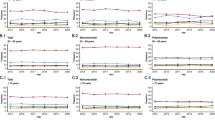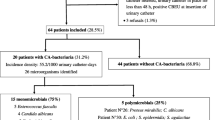Abstract
Enterococci are of considerable relevance in the hospital setting. Their most common location is the urinary tract, where they may be responsible for both colonization and infections. They are often associated with the presence of other microorganisms. The aim was to compare monomicrobial and polymicrobial Enterococcus faecalis bacteriuria. A retrospective study was performed on the demographic, clinical, and laboratory data of 299 patients who had presented with E. faecalis bacteriuria in 2012 at a University Hospital. The bacteriuria was polymicrobial in 46.1 % of cases and in 36.4 % of cases was responsible for a urinary tract infection. Infections appeared to be more prevalent in the polymicrobial than the monomicrobial group (42 % vs 32 %, p = 0.06). Half of the patients who presented with urinary tract colonization received antibiotic treatment (54/ out of 10). A multivariate analysis adjusted for age (adjusted odds ratio [AOR] = 1.02 per year, p = 0.006), gender (AOR = 2.2, p = 0.007), and clinical classification (colonization or infection, AOR = 1.6, p = 0.091), showed that diabetes mellitus (AOR = 2.0, p = 0.04), hospital length of stay exceeding 28 days (AOR = 2.0, p = 0.03), and presence of a urinary catheter (AOR = 2.4, p = 0.001) were all factors associated with polymicrobial E. faecalis bacteriuria. A reduction in the length of hospital stay and the use of urinary catheters would appear to be required to decrease the incidence of urinary tract colonization and infections by polymicrobial E. faecalis. Improper use of antibiotics to treat urinary tract colonization remains a major concern.

Similar content being viewed by others
References
Low DE, Keller N, Barth A, Jones RN (2001) Clinical prevalence, antimicrobial susceptibility, and geographic resistance patterns of enterococci: results from the SENTRY Antimicrobial Surveillance Program, 1997–1999. Clin Infect Dis 32 [Suppl 2]:S133–S145. doi:10.1086/320185
Kang J, Sickbert-Bennett EE, Brown VM, Weber DJ, Rutala WA (2012) Relative frequency of health care-associated pathogens by infection site at a university hospital from 1980 to 2008. Am J Infect Control 40:416–420. doi:10.1016/j.ajic.2011.06.013
Laupland KB, Bagshaw SM, Gregson DB, Kirkpatrick AW, Ross T, Church DL (2005) Intensive care unit-acquired urinary tract infections in a regional critical care system. Crit Care 9:R60–R65. doi:10.1186/cc3023
Hooton TM (2012) Clinical practice. Uncomplicated urinary tract infection. N Engl J Med 366:1028–1037. doi:10.1056/NEJMcp1104429
Raveh D, Rosenzweig I, Rudensky B, Wiener-Well Y, Yinnon AM (2006) Risk factors for bacteriuria due to Pseudomonas aeruginosa or Enterococcus spp in patients hospitalized via the emergency department. Eur J Clin Microbiol Infect Dis 25:331–334. doi:10.1007/s10096-006-0140-0
Shankar N, Lockatell CV, Baghdayan AS, Drachenberg C, Gilmore MS, Johnson DE (2001) Role of Enterococcus faecalis surface protein Esp in the pathogenesis of ascending urinary tract infection. Infect Immun 69:4366–4372. doi:10.1128/IAI.69.7.4366-4372.2001
Gołębiewska J, Dębska-Ślizień A, Komarnicka J, Samet A, Rutkowski B (2011) Urinary tract infections in renal transplant recipients. Transplant Proc 43:2985–2990. doi:10.1016/j.transproceed.2011.07.010
Lloyd S, Zervos M, Mahayni R, Lundstrom T (1998) Risk factors for enterococcal urinary tract infection and colonization in a rehabilitation facility. Am J Infect Control 26:35–39
Lin E, Bhusal Y, Horwitz D (2012) Overtreatment of enterococcal bacteriuria. Arch Intern Med 172(1):33–38. doi:10.1001/archinternmed.2011.565
Sotto A, Lefrant JY, Fabbro-Peray P, Muller L, Tafuri J, Navarro F et al (2002) Evaluation of antimicrobial therapy management of 120 consecutive patients with secondary peritonitis. J Antimicrob Chemother 50:569–576
Djahmi N, Boutet-Dubois A, Nedjai S, Dekhil M, Sotto A, Lavigne J-P (2012) Molecular epidemiology of Enterococcus sp. isolated in a university hospital in Algeria. Scand J Infect Dis 44:656–662. doi:10.3109/00365548.2012.673232
Seno Y, Kariyama R, Mitsuhata R, Monden K, Kumon H (2005) Clinical implications of biofilm formation by Enterococcus faecalis in the urinary tract. Acta Med Okayama 59:79–87
Croxall G, Weston V, Joseph S, Manning G, Cheetham P, McNally A (2011) Increased human pathogenic potential of Escherichia coli from polymicrobial urinary tract infections in comparison to isolates from monomicrobial culture samples. J Med Microbiol 60:102–109. doi:10.1099/jmm.0.020602-0
Tambyah PA, Maki DG (2000) Catheter-associated urinary tract infection is rarely symptomatic: a prospective study of 1497 catheterized patients. Arch Intern Med 160(5):678–682
Grabe M, Bjerklund-Johansen TE, Botto H (2013) Guidelines on urological infections. European Association of Urology. http://uroweb.org/wp-content/uploads/18_Urological-infections_LR.pdf. Limited update March 2013
Etienne M, Chavanet P, Sibert L, Michel F, Levesque H, Lorcerie B et al (2008) Acute bacterial prostatitis: heterogeneity in diagnostic criteria and management. Retrospective multicentric analysis of 371 patients diagnosed with acute prostatitis. BMC Infect Dis 8:12. doi:10.1186/1471-2334-8-12
Ministère de la santé, de la jeunesse et des sports DGS/DHOS, CTINILS (2007) Actualisation de la définition des Infections Nosocomiales. http://www.sante.gouv.fr/IMG/pdf/rapport_complet.pdf. Accessed 11 May 2007
Magliano E, Grazioli V, Deflorio L, Leuci AI, Mattina R, Romano P et al (2012) Gender and age-dependent etiology of community-acquired urinary tract infections. Sci World J 2012:349597. doi:10.1100/2012/349597
Beerepoot MAJ, ter Riet G, Nys S, van der Wal WM, de Borgie CAJM, de Reijke TM et al (2011) Cranberries vs antibiotics to prevent urinary tract infections: a randomized double-blind noninferiority trial in premenopausal women. Arch Intern Med 171:1270–1278. doi:10.1001/archinternmed.2011.306
Cove-Smith A, Almond MK (2007) Management of urinary tract infections in the elderly. Trends Urol Gynecol Sex Health 12:31–34. doi:10.1002/tre.33
Donlan RM, Costerton JW (2002) Biofilms: survival mechanisms of clinically relevant microorganisms. Clin Microbiol Rev 15:167–193
Givens CD, Wenzel RP (1980) Catheter-associated urinary tract infections in surgical patients: a controlled study on the excess morbidity and costs. J Urol 124:646–648
Tsuchimori N, Hayashi R, Shino A, Yamazaki T, Okonogi K (1994) Enterococcus faecalis aggravates pyelonephritis caused by Pseudomonas aeruginosa in experimental ascending mixed urinary tract infection in mice. Infect Immun 62:4534–4541
Hooton TM, Roberts PL, Cox ME (2013) Voided midstream urine culture and acute cystitis in premenopausal women. N Eng J Med 369(20):1883–1891. doi:10.1056/NEJMoa1302186
Lavigne J-P, Nicolas-Chanoine M-H, Bourg G, Moreau J, Sotto A (2008) Virulent synergistic effect between Enterococcus faecalis and Escherichia coli assayed by using the Caenorhabditis elegans model. PLoS One 3, e3370. doi:10.1371/journal.pone.0003370
Prabhu A, Taylor P, Konecny P, Brown MA (2013) Pyelonephritis: what are the present day causative organisms and antibiotic susceptibilities? Nephrology (Carlton) 18:463–467. doi:10.1111/nep.12062
Cai T, Mazzoli S, Meacci F, Boddi V, Mondaini N, Malossini G et al (2011) Epidemiological features and resistance pattern in uropathogens isolated from chronic bacterial prostatitis. J Microbiol 49:448–454. doi:10.1007/s12275-011-0391-z
Cai T, Mazzoli S, Mondaini N, Meacci F (2012) The role of asymptomatic bacteriuria in young women with recurrent urinary tract infections: to treat or not to treat? Clin Infect Dis 55(6):771–777. doi:10.1093/cid/cis534
Waites KB, Chen Y, DeVivo MJ, Canupp KC (2000) Antimicrobial resistance in gram-negative bacteria isolated from the urinary tract in community-residing persons with spinal cord injury. Arch Phys Med Rehabil 81(6):764–769
Scientific board of ONERBA (2014) Annual Report 2011–12/rapport d’activité 2011–12. Observatoire National de l’Epidémiologie de la Résistance Bactérienne aux Antibiotiques (ONERBA). http://www.onerba.org/IMG/pdf/onerba_rapport_2011_cha6-3.pdf
Acknowledgements
We would like to thank Jack Goodfellow and Mark Jones for English revision and improvement.
Conflict of interest
The authors declare that they have no conflict of interest.
Author information
Authors and Affiliations
Corresponding author
Rights and permissions
About this article
Cite this article
Fourcade, C., Canini, L., Lavigne, JP. et al. A comparison of monomicrobial versus polymicrobial Enterococcus faecalis bacteriuria in a French University Hospital. Eur J Clin Microbiol Infect Dis 34, 1667–1673 (2015). https://doi.org/10.1007/s10096-015-2403-0
Received:
Accepted:
Published:
Issue Date:
DOI: https://doi.org/10.1007/s10096-015-2403-0




